Throughout history beds have been a vital piece of family furniture, often becoming artefacts of great importance due to their insight into how our ancestors lived. Today, many antique beds find their way back into modern homes due to their visual appeal or status as an heirloom. As functional items, historic beds often require routine maintenance or restoration work to continue serving their purpose as comfortable, classic furniture. This is where our specialists step in to help you preserve and protect valuable bed frames, posts, headboards and upholstery.
 Above: detail from ‘Den syge pige’ by Michael Ancher, 1882
Above: detail from ‘Den syge pige’ by Michael Ancher, 1882
How we sleep is an intimate and unequivocally relatable aspect of humanity, making the history of beds a fascinating topic. This article will cover the development of beds, as well as tips on how to care for antique pieces in your home. Our furniture specialists recently restored a grand four-poster bed of great ancestral importance, at the end of the article we will share information on this process and the results that can be achieved through historically-sensitive repairs.
 Above: a selection of wooden framed antique beds, these drawings are from the 1930s
Above: a selection of wooden framed antique beds, these drawings are from the 1930s
The history of beds
Ancient evidence of purpose-built sleeping areas dates back 200,000 years, these early examples commonly consist of materials such as leaves, moss and grass. Beds, as we would recognise them today, can be found in ancient Greece and Rome.
 Above: this neoclassical bed from the regency period has been inspired by a Roman lectus (daybed) it is dated to 1805–8
Above: this neoclassical bed from the regency period has been inspired by a Roman lectus (daybed) it is dated to 1805–8
Homer’s Odyssey famous describes the bed that Odysseus had created for himself and his wife, crafted from an olive tree inlaid with precious metals. Although this is fictional we can understand that ancient Greece had an understanding of bedframes as a key piece of furniture in the home. Ancient Romans typically ate their meals whilst lying on their side, therefore they had several types of beds in their home to serve different purposes. Rome is also one of the first examples of wool being in mattresses with a raised area at the head, the beds were often so high from the ground that they required steps.
 Above: a depiction of a bed in ‘Scenes from the Life of Saint John the Baptist’ by Francesco Granacci, 1506-07
Above: a depiction of a bed in ‘Scenes from the Life of Saint John the Baptist’ by Francesco Granacci, 1506-07
Throughout the middle ages, average households slept either on the floor or in curtained-off areas of the home. Aristocracy slept in silk-covered splendour, with the development of four-poster beds coming into fashion around the 14th century. Curtained sleeping areas and four-poster beds had a dual purpose of keeping the person warm whilst allowing for privacy either from family members or servants. During the 15th century nobility often moved around, making many grand beds easy to break down and set up again, it was not until the 16th century that large-scale, grand bedframes and upholstery became more commonplace.
 Above: a detail from ‘The Newborn Baby’ by Matthijs Naiveu, 1675
Above: a detail from ‘The Newborn Baby’ by Matthijs Naiveu, 1675
The ‘Sun King’ Louis XIV was renowned for extravagant splendour in his interiors, so it is in Versailles that we can find some of the most elaborate bed chambers history has to offer. Nobility would often have visitors directly to their bed, especially during times of childbirth or mourning, so rather than being intimate, the bed was a performative space that could be used to denote status. As a key feature in aristocratic homes, many ancestral beds may have coats of arms or family crests on the four-poster frame or headboard.
 Above: examples of typical late 17th century / early 18th century ‘tester beds’
Above: examples of typical late 17th century / early 18th century ‘tester beds’
Historic beds were made of wood, making them susceptible to woodworm and other pest infestations. It was due to this that iron beds began to take over in the 18th century, advertised as being more hygienic. Metal frames were often painted with enamel and later white lead paint, making this hygienic option poisonous to babies and young children. By the mid-19th century, there was a revival in wooden frames, typically in keeping with the fashion of gothic revival interiors or the later arts and crafts movement.
 Above: in the 18th century the bedroom was not a private place, as seen in this etching from 1770
Above: in the 18th century the bedroom was not a private place, as seen in this etching from 1770
The rise of the middle class during the industrial revolution and late 19th century saw more and more families able to afford previously luxurious sleeping arrangements. Bed frames had historically been one of the most expensive pieces of furniture in the home and therefore synonymous with wealth. Wooden bed frames that replicated or hinted towards these status symbols of the past were therefore much admired and sought after in late Victorian, Edwardian and early 20th century homes. Many heirloom beds that still exist in family homes today can be dated to this period.
 Above: a drawing of a late 19th century bedroom with a gothic revival style bed
Above: a drawing of a late 19th century bedroom with a gothic revival style bed
Antique bed value
Genuine historic beds that can be dated to the 17th century and earlier are very rare and can reach high prices at auction. Early beds in Britain are typically made of oak, but you should watch out for later reproductions that may either be Victorian gothic revival styles or even modern beds that use synthetic resin disguised as wood for decorative elements.
Victorian revival styles are generally machine-made and therefore easy to spot when you look for the joins and the thickness of any veneers (very thin veneers indicate machinery being used), any hand-cut, hand-crafted bed frames may indicate an early piece that was produced prior to the industrial revolution. You may find that your bed is made up of a mixture of eras, as older frames, posts or boards may have been included in later periods. If you see any keyholes or joins that lead nowhere or seem out of place, this may indicate several eras mixed together.
- In June 2022 a Louis XVI style bed sold for 25,200 euros at Christie’s Paris
- In January 2022 a 19th century gothic revival bed frame sold for £16,380 at Sotheby’s London
- In 2020 a George III style bed sold for $10,625 at Sotheby’s New York
- In 2017 an art deco bed by Émile-Jacques Ruhlmann sold for $35,000 at Christie’s New York
- In 2013 a bed frame dated to 1770 sold for £5,000 at Christie’s London
 Above: a late 19th century bedstead made of birds eye maple and tulip poplar dated to 1881–84
Above: a late 19th century bedstead made of birds eye maple and tulip poplar dated to 1881–84
Caring for a wooden antique bed frame
The first point to note for antique beds is that they are typically not in keeping with standard mattress sizes, therefore they may require one to be specially made to their measurements. Trying to fit in a mattress that is too large or too small may result in damage to the frame, so it is important to ensure that this is taken care of before the bed is put to use. You may also want to consider having any part of the frame that will carry weight – such as wooden slats – to be assessed and strengthened before it is used as a functional item.
Antique wood should not be cleaned with household chemicals or off-the-shelf mixtures, if there is a build-up of dust this should be gently cleared away with a dry, microfibre cloth. Wooden furniture needs a certain level of moisture to avoid drying out and becoming brittle, you can apply a homemade 50/50 solution of boiled linseed oil and turpentine to keep it in good condition.
 Above: a selection of the traditional tools and solutions used by our furniture experts
Above: a selection of the traditional tools and solutions used by our furniture experts
It is best practice to keep any wooden antique furniture around 2ft from any heat source to stop the natural moisture in the wood from evaporating. You should also avoid humid areas to avoid constant fluctuations in atmospheric absorption.
The joints in bed frames loosen or become unstable over time, either due to their frequent use or due to the expansion and contraction of wood. A slight wobble in the structure may seem no more than a nuisance, but if the piece continues to be used it may worsen and lead to breakages in the joins, feet or slats.
 Above: an example of woodworm holes to look out for
Above: an example of woodworm holes to look out for
If you come across pests such as woodworm, always consult an expert. Even historic infestations (appearing as holes that no longer seem occupied) can encourage the return of insects and the continued weakening of the structure. Our furniture specialists can eliminate woodworm before filling these holes to avoid future deterioration.
Antique bed restoration
Beds often come to our studio for the stabilisation of loose joins and the repair of broken pieces. Our team uses historically sourced materials to keep your bed as historically accurate as possible, including salvaged veneers, inlays, feet, posts and boards. They also use traditional adhesives and techniques to ensure the integrity of the piece as an antique item.
 Above: the bed drawing before and after restoration by our paper and frame conservators
Above: the bed drawing before and after restoration by our paper and frame conservators
In spring 2022 our furniture expert Dean restored an ancestral four-poster oak bed, reviving broken areas and unstable joins. The bed was of such significance to the family that a drawing of it exists from the 18th century – the paper had become discoloured due to acidic framing materials, so our paper conservator restored this alongside the repair of the bed itself. The text on the drawing reads:
“Anno 1345 Nicholas Stanley Esq. married Constance daughter and sole heir of Thomas of Austhwaite Lord of Austhwaite; at which time this oak bedstead is supposed to have been made and has descended from ancestor to heir to George Edward Stanley Esq. the current possessor AD. 1794”
Our furniture team were called in to assess this important piece of family furniture, noting that there were many areas of deterioration as you might expect from a bed of this age. Sensitive restoration of the missing, broken and unstable areas was proposed and over the course of a week our expert worked on-site at Dalegarth Hall.
 Above: the process of restoring a broken corner on the bedpost by our furniture specialist
Above: the process of restoring a broken corner on the bedpost by our furniture specialist
As the furniture was still serving as a functional piece, the most obvious requirement for strengthening and repair was the wooden slats that uphold the mattress. These were replaced, alongside other missing areas such as the lower skirting boards, with reclaimed timber. Our furniture restoration studio has an abundance of salvaged and antique-sourced materials, these can be cut to size, accurately carved and colour-matched to blend in with the original wood.
 Above: details from the bed frame that required professional cleaning due to numerous small crevices
Above: details from the bed frame that required professional cleaning due to numerous small crevices
Losses were present in decorative areas upon the posts and canopy, these were either re-adhered and strengthened or replaced with new pieces that were carved to match the original design.
The bed was also cleaned extensively, sensitively removing decades, if not centuries, of dust build-up in the smallest crevices. The wood was then finished with wax, helping to protect it from moisture and atmospheric particles whilst allowing it to appear refreshed and ready to return to good use.
How can we help?
If you have a bed frame or similar piece of antique furniture that requires assessment, repair or a full restoration, please speak to our helpful team for further advice.
You can get in touch by emailing [email protected] or call 0207 112 7576 for a conversation about our services.

 Above: detail from ‘Den syge pige’ by Michael Ancher, 1882
Above: detail from ‘Den syge pige’ by Michael Ancher, 1882 Above: a selection of wooden framed antique beds, these drawings are from the 1930s
Above: a selection of wooden framed antique beds, these drawings are from the 1930s Above: this neoclassical bed from the regency period has been inspired by a Roman lectus (daybed) it is dated to 1805–8
Above: this neoclassical bed from the regency period has been inspired by a Roman lectus (daybed) it is dated to 1805–8 Above: a depiction of a bed in ‘Scenes from the Life of Saint John the Baptist’ by Francesco Granacci, 1506-07
Above: a depiction of a bed in ‘Scenes from the Life of Saint John the Baptist’ by Francesco Granacci, 1506-07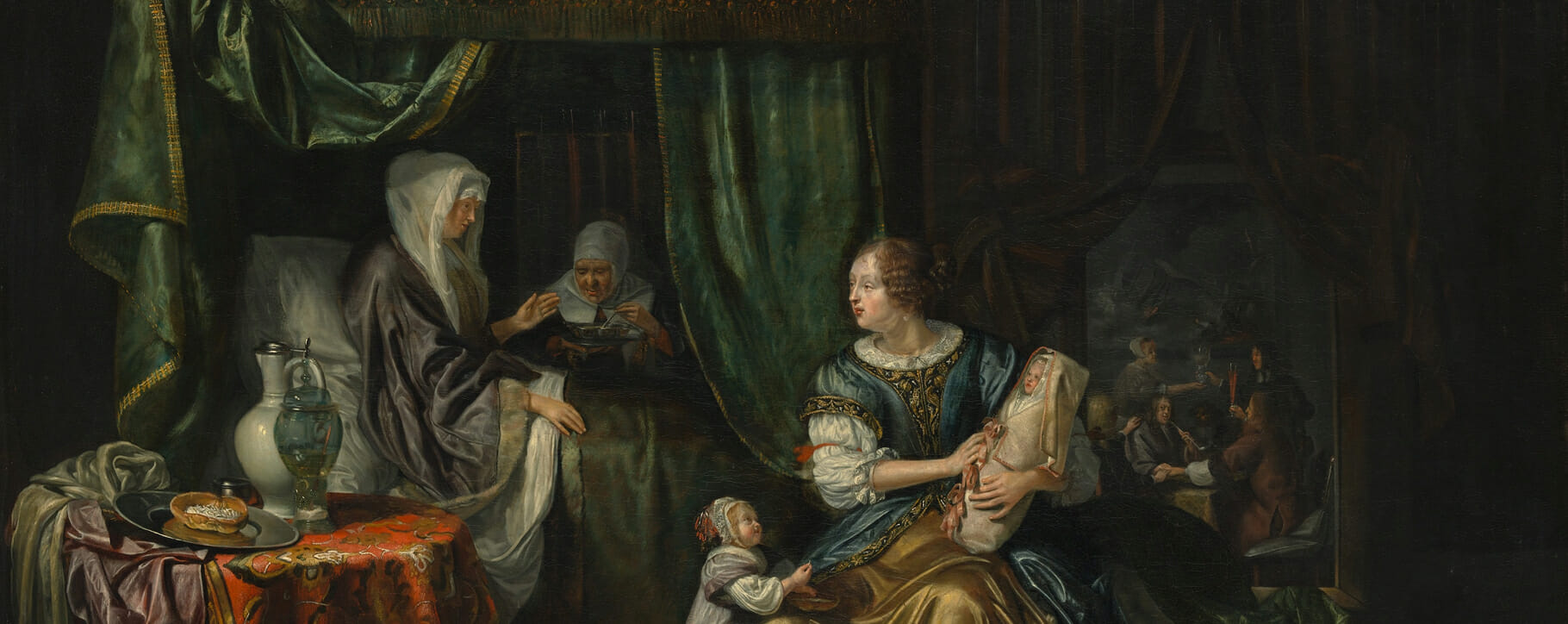 Above: a detail from ‘The Newborn Baby’ by Matthijs Naiveu, 1675
Above: a detail from ‘The Newborn Baby’ by Matthijs Naiveu, 1675 Above: examples of typical late 17th century / early 18th century ‘tester beds’
Above: examples of typical late 17th century / early 18th century ‘tester beds’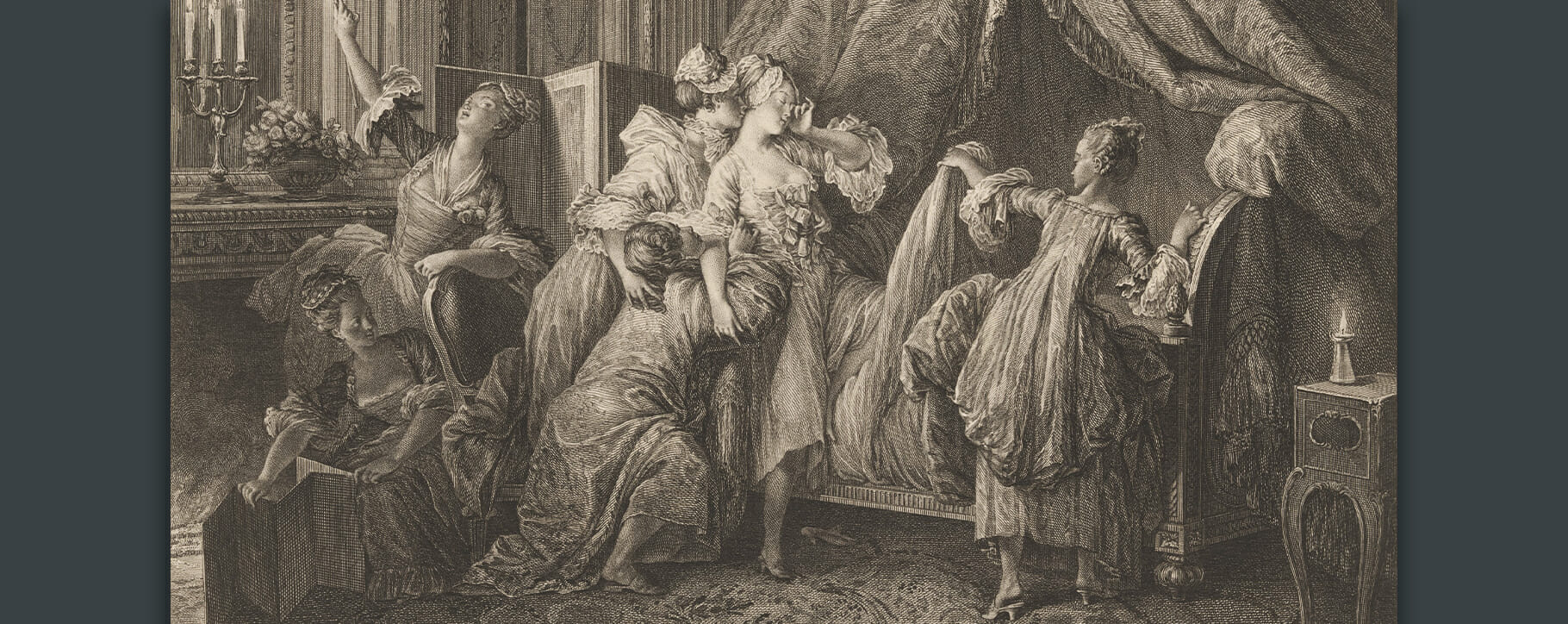 Above: in the 18th century the bedroom was not a private place, as seen in this etching from 1770
Above: in the 18th century the bedroom was not a private place, as seen in this etching from 1770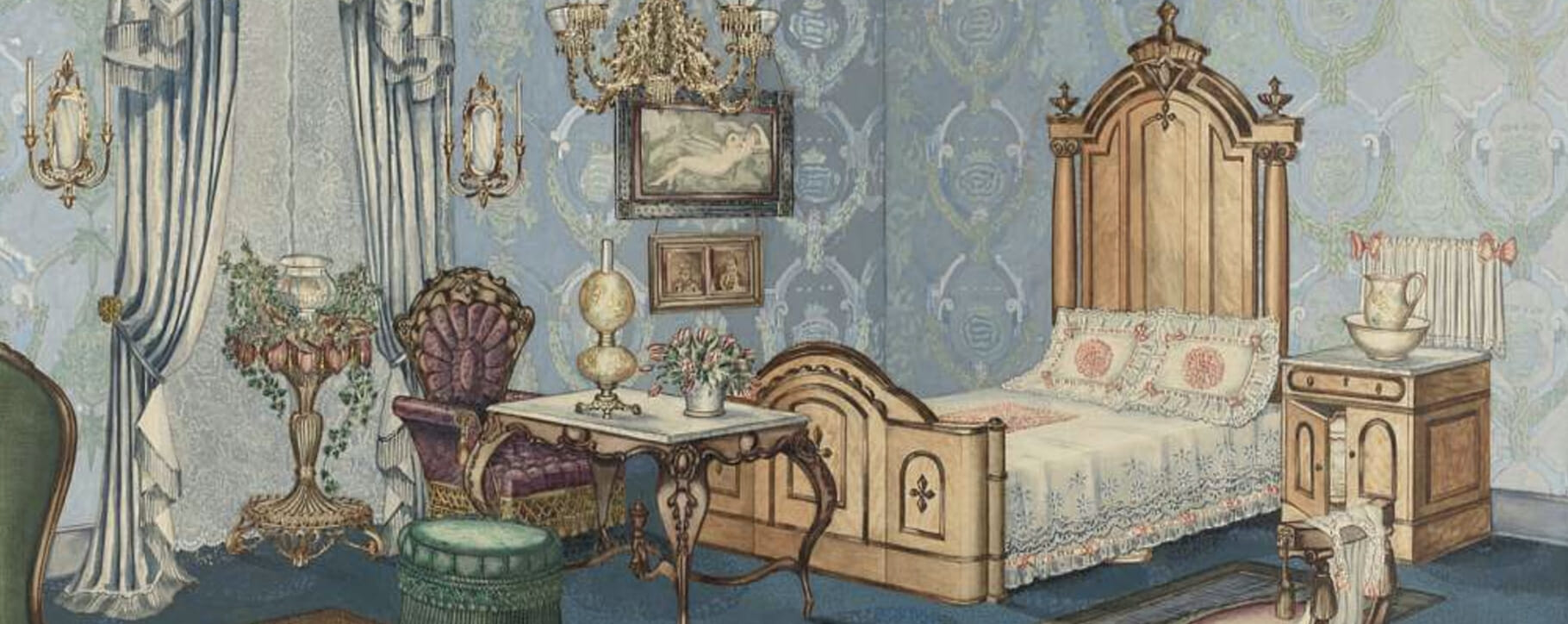 Above: a drawing of a late 19th century bedroom with a gothic revival style bed
Above: a drawing of a late 19th century bedroom with a gothic revival style bed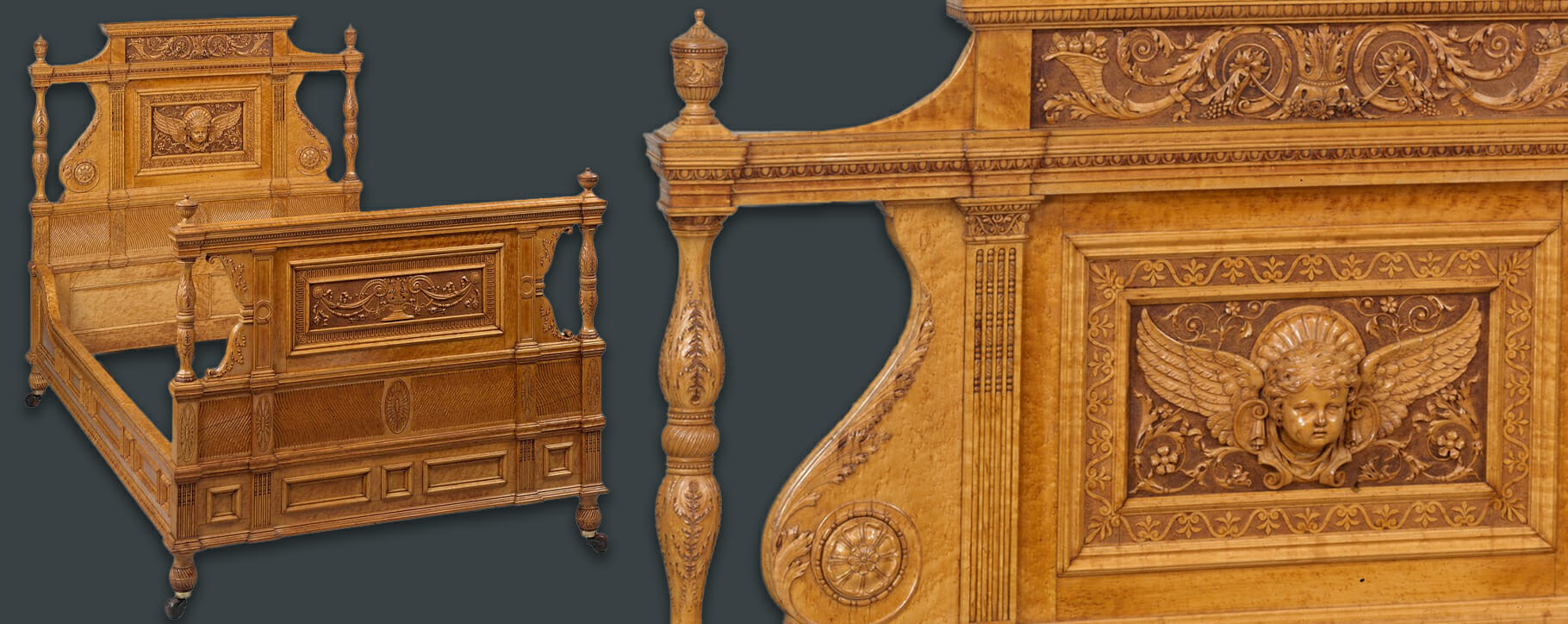 Above: a late 19th century bedstead made of birds eye maple and tulip poplar dated to 1881–84
Above: a late 19th century bedstead made of birds eye maple and tulip poplar dated to 1881–84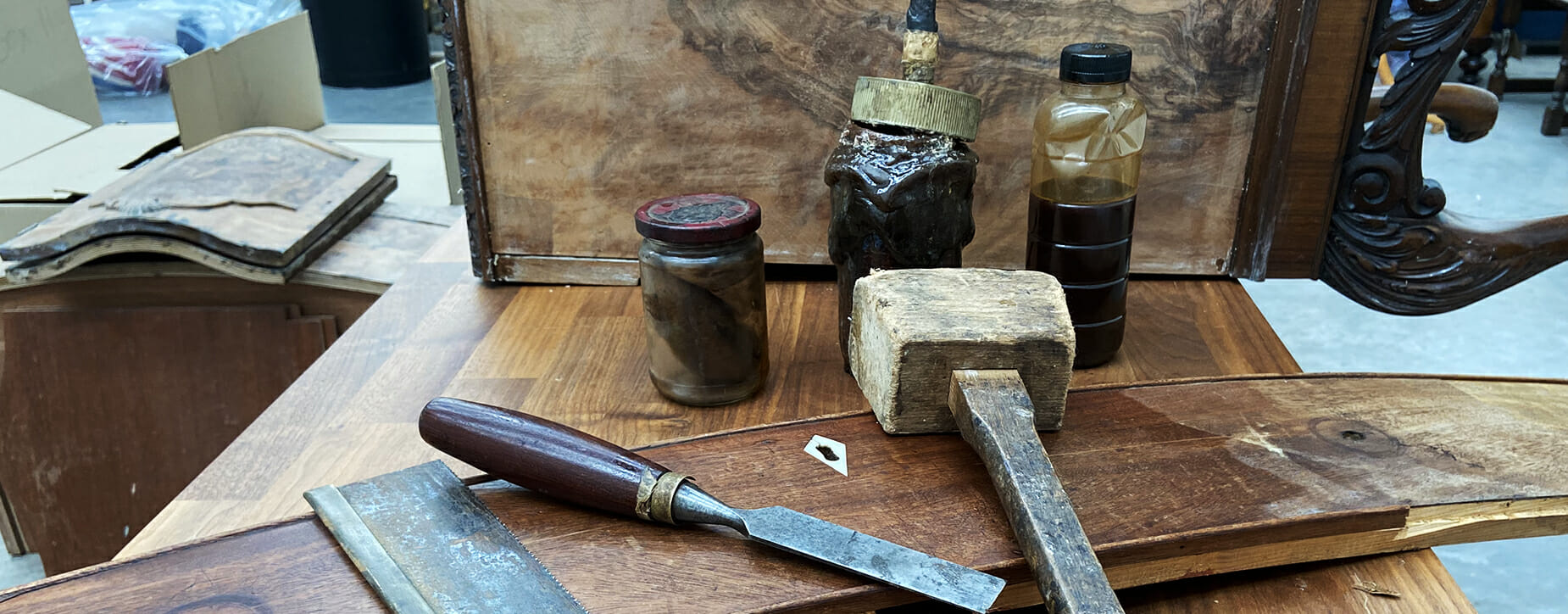 Above: a selection of the traditional tools and solutions used by our furniture experts
Above: a selection of the traditional tools and solutions used by our furniture experts Above: an example of woodworm holes to look out for
Above: an example of woodworm holes to look out for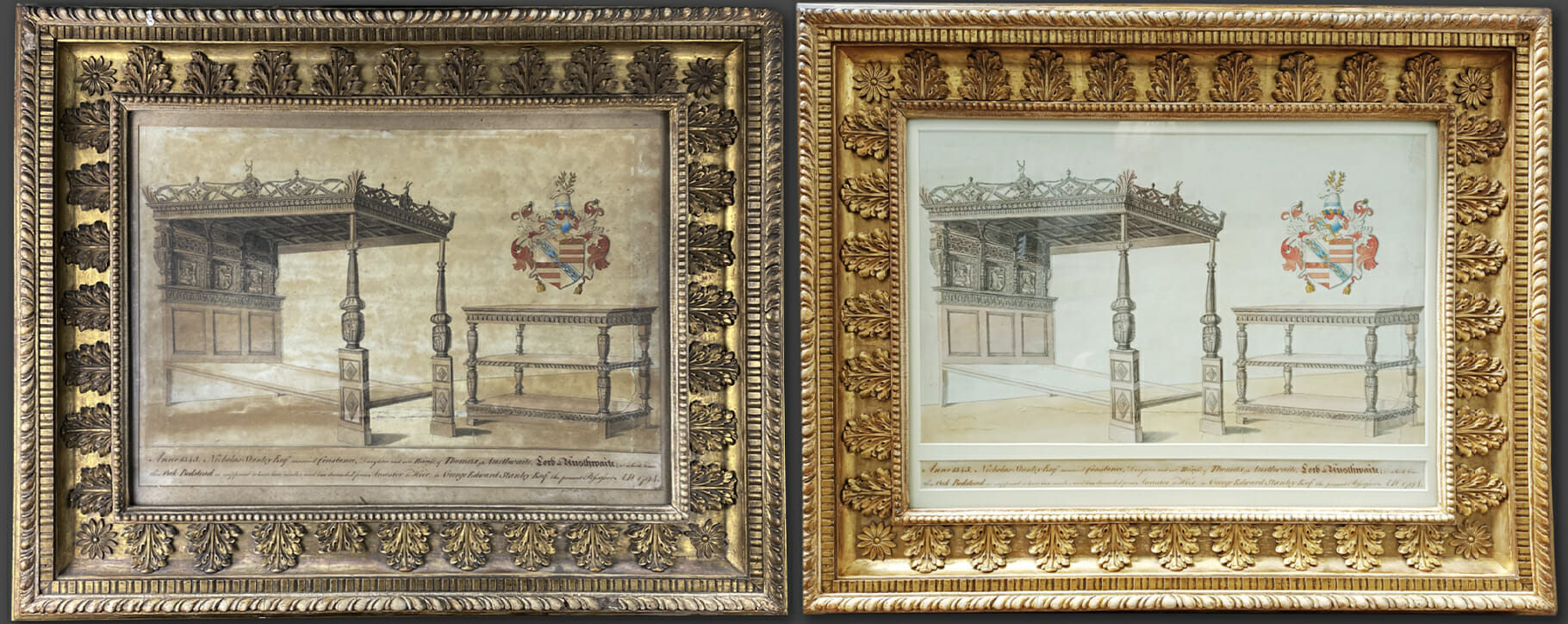 Above: the bed drawing before and after restoration by our paper and frame conservators
Above: the bed drawing before and after restoration by our paper and frame conservators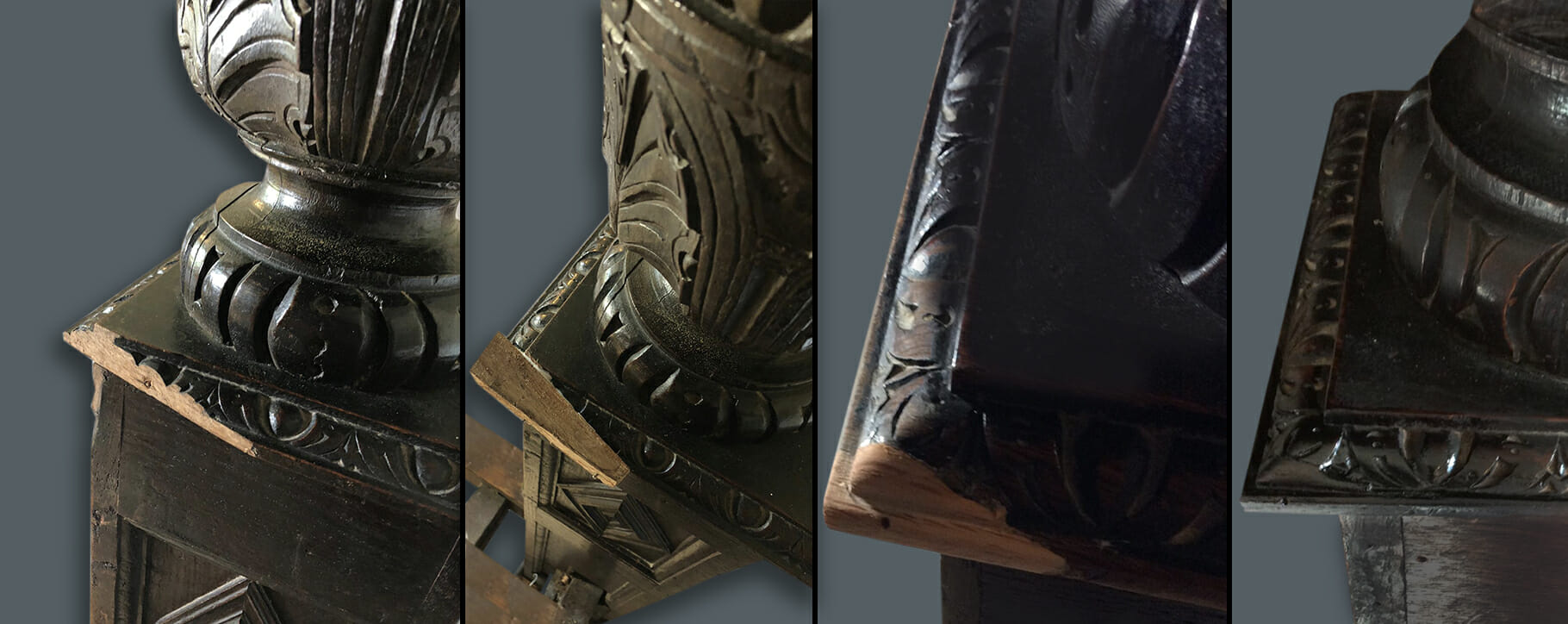 Above: the process of restoring a broken corner on the bedpost by our furniture specialist
Above: the process of restoring a broken corner on the bedpost by our furniture specialist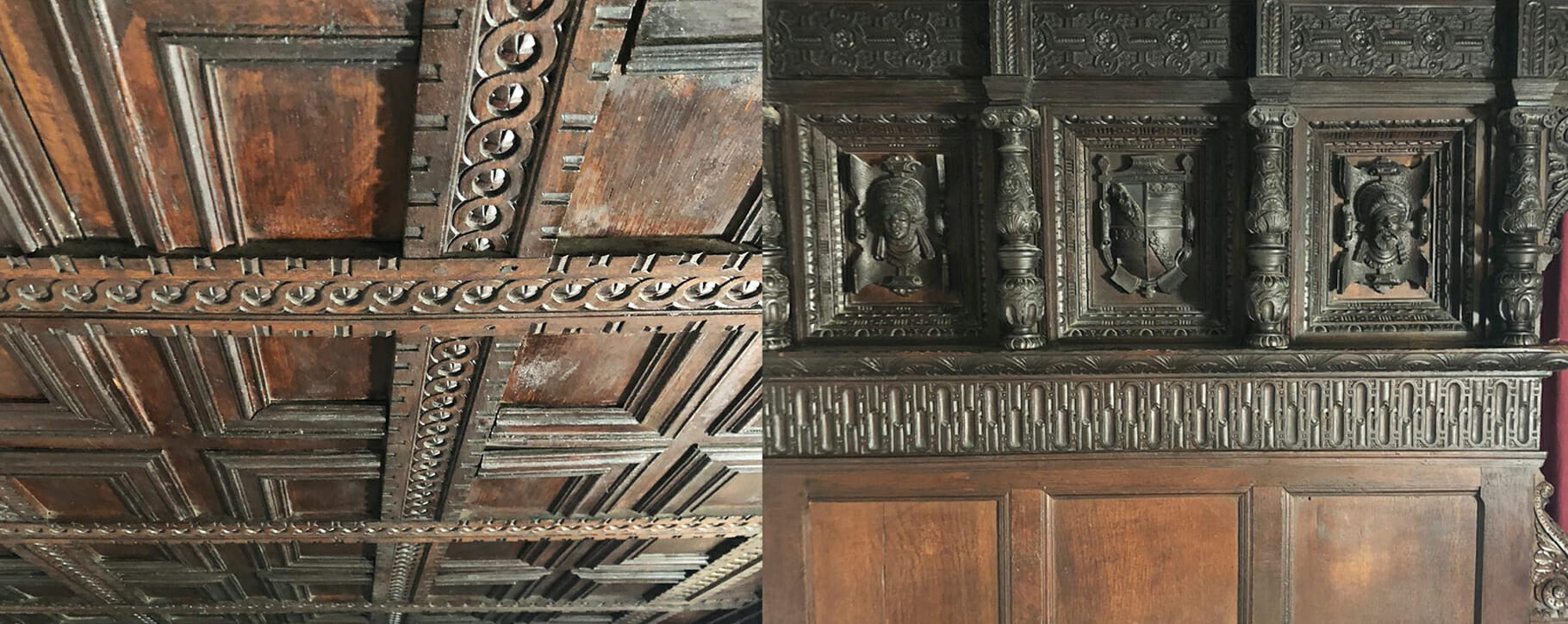 Above: details from the bed frame that required professional cleaning due to numerous small crevices
Above: details from the bed frame that required professional cleaning due to numerous small crevices




